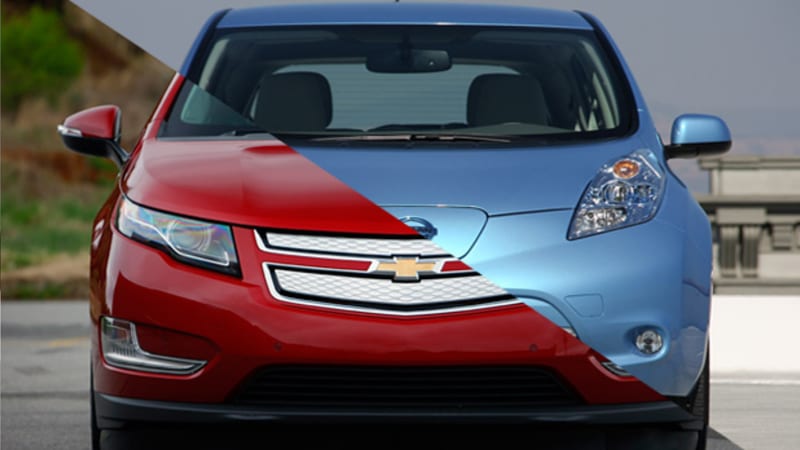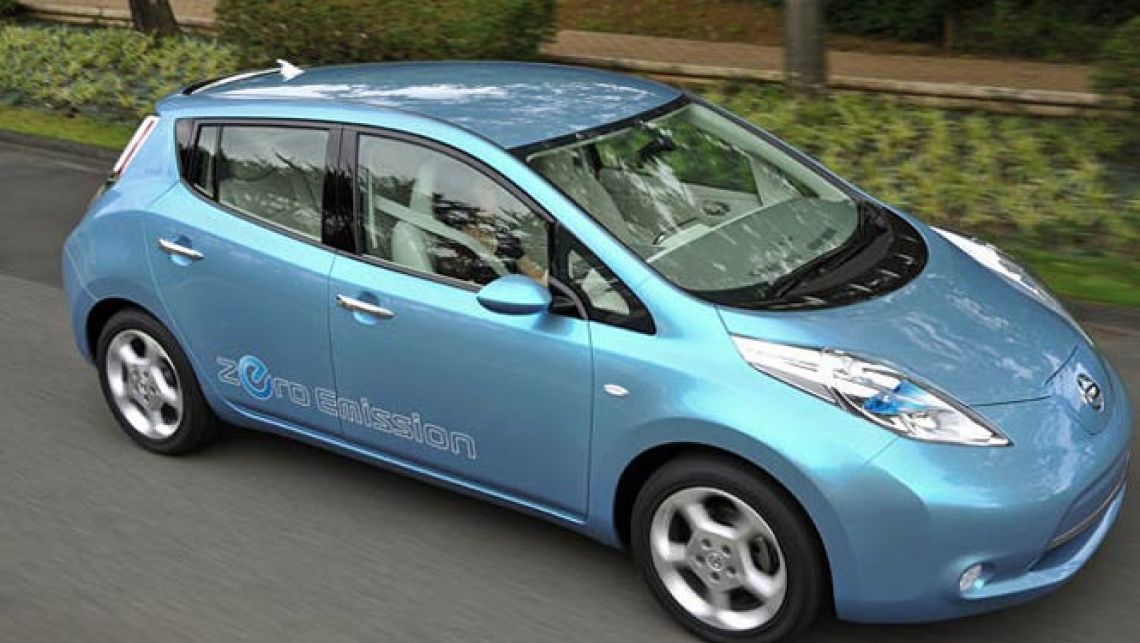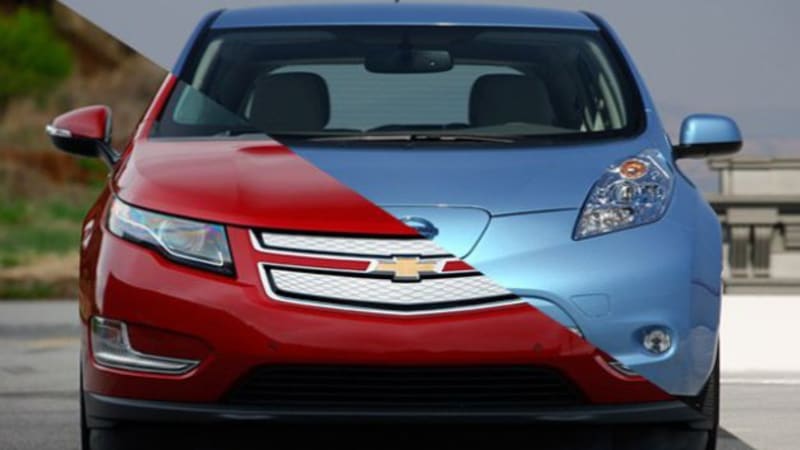California has sold 102,440 EVs since Volt, Leaf went on sale in 2010

CARB's Mary Nichols drives a Honda Fit EV, and said that in LA, it's no longer "a weird thing."
The chairman of the California Air Resources Board (CARB), Mary Nichols, took a broad overview. Nichols herself drives a Honda Fit EV, and said that in her home of Los Angeles, that's no longer "a weird thing." She told AutoblogGreen that, "The industry people that we work with are very clear about this, they think the electric cars sell themselves, in terms of their driveability and attractiveness, if you can get a person into one," she said. "The best way to get a person into one is for them to see it somewhere, and that's really what we're celebrating here. As you get to critical mass, and I think 100,000 vehicles is getting to that point, people start looking at these as an option as opposed to something that they walked into the dealership already wanting to get."
Given CARB's support of hydrogen vehicles as well as EVs, we had to ask Nichols when she thought H2 would hit the 100,000-vehicle milestone. She declined to answer that question, but did say that, "Hydrogen vehicles are just beginning to be available in the market. They are just being very selectively and even more cautiously introduced than plug-in vehicles because of concerns that customers will have a good experience, and a good experience means that there has to be an adequate supply of fueling stations," she said. "There has been a lot of expression of interest and support and vision in this direction but we are just at the beginning stages, where we were with plug-in vehicles a few years ago. It's going to take a while."
If you ask Nissan's Brendan Jones how a state can support a new technology like plug-in vehicles, he will point to how EVs were rolled out in California. Turns out, the company has learned a lot from selling so many Leafs there. "When you look at California, they provided a very fertile ground for our initial success with our vehicle, from the first vehicle in 2010 in San Francisco," he said. "Ever since then, it has provided both fertile ground for learning how customers interact with the vehicle to improving our best practices at our dealers, improving the infrastructure. If you look at where we've been and where we're going, everything in that equation starts with California and that very first sale. Those best practices have exploded across the country."
"We are very, very, very energized by this milestone." – PEV Collaborative's Christine Kehoe
Nissan recently passed 130,000 Leaf sales globally, and now sells around 5,000 units of the EV each month around the world. Despite increased competition in California – where there are around 15 plug-in vehicles available, compared to just two or three in the rest of the US – the Leaf remains a top seller there. Looking beyond the Leaf, California makes up 40 percent of all EV sales in the US. "Since the US is a leader and we're leading in the US, I guess we are the global leader," California Plug-In Electric Vehicle Collaborative executive director Christine Kehoe told AutoblogGreen. "This is a significant milestone that we see as a way to let consumers know that EVs are a real choice, that it can work in their daily lives. It frees them from the gas pump because they can fill up at home. We're going to continue to grow this market in CA. We are very, very, very energized by this milestone."Show full PR text California Surpasses 100,000 Plug-in Car Sales
New sales figures show Californians buying 40 percent of nation's plug-in cars
SACRAMENTO, Calif. – California sped past a major mile-marker this week – selling more than 100,000 plug-in cars since the market started in 2010, according to the California Plug-In Electric Vehicle Collaborative.
Electric vehicle sales have risen steadily over the last several years – and this new milestone drives California closer to achieving Gov. Brown's goal of 1.5 million electric cars on the road by 2025.
"California's plug-in electric vehicle market is ramping up, and we expect to see significant growth over the next ten years as customers realize how economical and convenient they are," said California Plug-In Electric Vehicle Collaborative Executive Director Christine Kehoe.
Californians buy approximately 40 percent of all the PEVs sold in the U.S. According to data collected by the California Air Resources Board, new sales figures released this week from hybridcars.com and Baum & Associates, a Michigan-based market research firm, Californians bought 102,440 PEVs from December 2010 through August 2014.
"Drivers want high quality, high performing vehicles that use less or even no gasoline at all." Said General Motors' Robert Babik, Director, Vehicle Emissions, Issues, Environment, Energy, and Safety Policy. "We're proud that Chevrolet and Cadillac's line-up of plug in vehicles is helping to meet the growing demand head on."
"California was the site of the world's first Nissan LEAF delivery and has been the leading state for our 60,000 U.S. LEAF sales," said Brendan Jones, director, Electric Vehicle Sales and Infrastructure Strategy for Nissan. "We thank the State of California for actively supporting the adoption of electric cars and for helping us make LEAF the best-selling EV on the market today."
"With the Fusion Energi, C-MAX Energi and Focus Electric, Californians have several choices for plug-in vehicles," said Ford Motor Company's Director of Sustainable Business Strategies Mike Tinskey. "Ford customers drive a half-million miles a day on electricity and we are working hard not only to expand the number of all-electric miles, but also find innovative ways to maximize the number that are carbon-free."
In addition to automakers rolling out dozens of plug-in electric vehicle models for consumers over the next couple of years, utilities are working to provide a clean, reliable and affordable fuel source for plug-in car owners. And, drivers have increasing options to refuel at home overnight or charge at workplaces across the state.
"Electric vehicles are an integral part of California's cleaner future. With more than 10,000 electric vehicles on the road in the SDG&E service territory today, it is evident that our customers are embracing the benefits of clean electric transportation," said James P. Avery, San Diego Gas & Electric (SDG&E) senior vice president of power supply. "SDG&E is committed to providing our customers with the clean energy, attractive electric rates and resources needed to support their electric vehicle needs."
Driving on electricity is the equivalent of driving for $1 per gallon of gasoline.
"We're pleased to be providing clean, affordable fuel for a growing number of drivers across the country," said Richard Lowenthal, Founder and Chief Technical Officer of ChargePoint. "Gasoline is 4 dollars a gallon in California and rising. Consumers want alternatives and we're here to help make the best alternative – electricity -- more accessible, and to make electric vehicles more appealing." ChargePoint's electricity fueling network is the world's largest and is growing to meet demand at the rate of 500 new charging ports each month.
For decades, California's leadership on automotive emissions standards has improved air quality despite population increases and economic growth – and plug-in cars are a key part of that effort.
"This milestone shows that industry and government can work together for the good of the environment and the good of the consumer," said California Air Resources Board Chairman Mary D. Nichols. "Automakers are proving on a daily basis that they can rise to the challenge to meet California's clean vehicle standards, advance the technology, and provide a wide range of affordable cars that are good to look at, fun to drive, and, of course, have zero emissions."
To learn more about PEVs and state and national monthly sales, visit the PEV Collaborative website at www.PEVCollaborative.org.
# # #
The California Plug-In Electric Vehicle Collaborative is a public/private organization focused on accelerating the adoption of PEVs to meet California's economic, energy and environmental goals. Using the expertise of each member, the PEV Collaborative convenes, collaborates and communicates on emerging PEV market trends and works to address challenges and enable strong PEV market growth.
The California Plug-In Electric Vehicle Collaborative has 41 member organizations that include automakers, utilities, charging equipment/network providers, health and environmental organizations, clean transportation advocates, government, and research and educational institutions.
Sign up for quarterly e-newsletters at http://www.pevcollaborative.org/newsletters to learn more about what the PEV Collaborative is working on. Source






